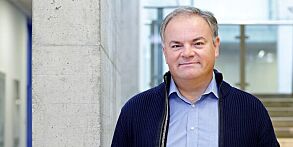Dr. Knoblich describes his work using organoids to understand mechanisms of human brain development
Dr. Jürgen Knoblich Talks Organoids

Dr. Jürgen Knoblich is Deputy Scientific Director of the Institute of Molecular Biotechnology (IMBA) of the Austrian Academy of Sciences in Vienna, and Adjunct Professor at the Medical University in Vienna. Dr. Knoblich is considered on of the leaders in the cerebral organoid field, having performed groundbreaking work in the development of this emerging technology. His research lab aims to understand the principle mechanisms of human brain development.
This Q&A has been transcribed from an audio interview.
How do you define organoids?
Madeline and I came up with a definition for organoids in a Science review.1 There, we say organoids have to recapitulate aspects of the three dimensional organization of the organ,an absolute prerequisite for something to be called an organoid. Organoids have to contain the cell types that are contained in that organ and have to be formed from stem cells (or from cultured cells) in vitro in the laboratory. That includes all of Hans Clevers’ organoids, our organoids; that includes essentially everything that has been called organoids. The definition does not include, for example, spheroids that contain all the neurons that are present in the brain, but do not have a ventricular zone and do not have a ventricle. I think we should get away from this feeling that one is superior to the other, and rather see that it just makes our lives easier if we have precise terminology that we can use. That way, we don't always have to discuss it and explain it. This is why I’m very much in favor of separating organoids, spheroids, and neurospheres.What has been the impact of using organoids on your research?
Since Madeline Lancaster developed this cerebral organoid protocol2 in my lab, the focus of the lab has shifted quite significantly. Traditionally, we were interested in a biological process called asymmetric cell division, a process whereby a stem cell generates both one cell that is continuing to be a stem cell and another cell that becomes more differentiated. Now, with the development of the organoid systems, our lab’s focus has become a lot broader. We are not only looking at basic biology, but also using organoids to model some of the major neuropsychiatric disorders, and we are even trying to model brain cancer.To what extent will organoids replace existing brain models?
For the field that I’m interested in, which is neural development, I think there really has been a shift of attention from classical rodent model organisms to the human system. Organoids are a fantastic model system—their unique aspect is they’re human. And I think they’re good for any scientific biological question that has a human-specific aspect to it. We should not forget that if we compare ourselves to animals, many organs are remarkably similar, but the brain and the parts of the brain we are interested in are just not similar. For that reason we do need models to actually test the human-specific aspects of the brain, and we need those models for the brain more than for any other organ.I think it is very important not to give people and policymakers the illusion that organoids are going to replace animal experiments. What I do think organoids are capable of doing is allowing us to make animal experiments in a more targeted manner, maybe to reduce their number and, most importantly, to then transfer the results that we have from animal experiments to the patient faster, more directly, and in a more successful and a more targeted manner.
Do you expect brain organoids to play a role in future breakthroughs in the field?
I think that within the next five years, a number of really important things are going to happen. I predict that the organoid technology will reach a point where we can study some of the big disorders. If we identify a certain mutation in a patient, and we feel this is associated with a certain disorder, we can test this. We can edit it. We can edit the genome and we can ask, was that mutation really important?So, I think we will arrive at a deeper genetic understanding of human disorders, and I also think we will arrive at a better mechanistic understanding of human neural developmental disorders. Basically, many of these studies are going to move from simple correlation to causality. I think we will be able to do the experiments and to ask the questions in a much more stringent manner. And there, I feel we’re going to see the biggest breakthroughs.
See the Organoid Resource Center for more information on culturing organoids and their applications, including webinars, publication lists, researcher profiles, and more.
References
- Lancaster MA and JA Knoblich. (2014) Organogenesis in a dish: modeling development and disease using organoid technologies. Science 345(6194): 1247125.
- Lancaster MA and JA Knoblich. (2014) Generation of cerebral organoids from human pluripotent stem cells. Nat Protoc 9(10):2329-40.
Request Pricing
Thank you for your interest in this product. Please provide us with your contact information and your local representative will contact you with a customized quote. Where appropriate, they can also assist you with a(n):
Estimated delivery time for your area
Product sample or exclusive offer
In-lab demonstration


